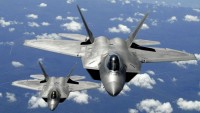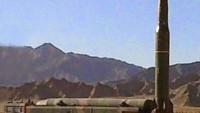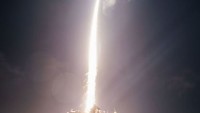Pearl Harbor-type Surprise Attack is China’s only Hope of Beating US in South China Sea War
| Arthur Dominic Villasanta | | Feb 07, 2017 09:50 PM EST |
(Photo : US Navy) Warships of the United States Pacific Fleet burn at Peral Harbor, 7 December 1941.
China's only realistic strategy to defeat the United States in the looming war over the South China Sea is to launch a Pearl Harbor-type surprise attack with ballistic missiles on U.S. Navy aircraft carriers patrolling Asian waters.
It might also involve missile strikes on Guam and Hawaii -- attacks which will certainly ignite World War III.
Like Us on Facebook
China will rely on its medium-range ballistic missiles (those with a range from over 1,000 km to 3,000 km) and intermediate-range ballistic missiles (those that can reach over 3,000 km to 5,000 km) based on the Chinese mainland to destroy the three U.S. Navy Nimitz-class aircraft carriers now in Asia.
Destroying all three carriers in a first strike, however, is considered an impossibility given the vulnerability of the "kill chain" necessary to secure fatal strikes on these fast moving warships, which are all protected by destroyers and cruisers armed with anti-missile systems.
It's not even certain if Chinese long-range reconnaissance can locate the carriers since China has no operational high-altitude, long endurance (HALE) aerial drones that will be needed to provide targeting data for Chinese missiles. Chinese spy satellites can't do this job.
This means the best option available to China will be to attack the American carriers while they're moored at Pearl Harbor. It will be 1941 all over again.
Some western military analysts believe a pre-emptive strike, or an attack without a declaration of war, is the only viable option for China given her qualitative and quantitative military inferiority versus the United States. Japan was in the same situation before the Dec. 7, 1941 surprise attack on Pearl Harbor.
A preemptive strike does appear consistent with what's known about the doctrine pervading the People's Liberation Army Rocket Force (PLARF), the service branch that controls all of China's ballistic missiles. Troubling new data and images also confirm that China might now be practicing this surprise attack.
Out of sight of the Chinese public, PLARF conducted a series of training exercises involving SRBMs and MRBMs during the Chinese New Year last Jan. 28. The drills were supposed to be directed against Taiwan, but are now suspected to be part of an overall training program aimed at finding and sinking U.S. Navy carriers on short notice.
On Jan. 28, separate PLARF brigades conducted combat drills involving deploying and practice firing the DF-11, an SRBM with a range of 300 km and an 800 kg high-explosive warhead; the DF-15 SRBM with a range of 600 km and a 500 kg high explosive warhead; the DF-16 MRBM with a range of 1,600 km and a 1,500 high explosive warhead and the DF-21C MRBM with a range of 2,500 km and a 500 kiloton nuclear warhead.
The brigades practiced different combat scenarios, including countering satellite reconnaissance and electronic jamming. The missile crews also practiced multiple maneuvers such as rapid loading; redeployment and launch sequence.
TagsPearl Harbor, china, surprise attack, U.S. Navy, aircraft carriers, medium range ballistic missiles, intermediate-range ballistic missiles, Dec. 7, 1941
©2015 Chinatopix All rights reserved. Do not reproduce without permission
 China’s Utter Defeat in a War vs the US Might Trigger Civil War in China and Destruction of the Communist Party
China’s Utter Defeat in a War vs the US Might Trigger Civil War in China and Destruction of the Communist Party China’s Missile Force Conducts Drills of DF-16 and other Ballistic Missiles Targeting Taiwan
China’s Missile Force Conducts Drills of DF-16 and other Ballistic Missiles Targeting Taiwan First Test of US Navy’s Most Advanced SM-3 Anti-Missile and Anti-Satellite Interceptor Succeeds
First Test of US Navy’s Most Advanced SM-3 Anti-Missile and Anti-Satellite Interceptor Succeeds China says US should Shut-up and Acquiesce to its Demand it owns Japan’s Senkaku Islands
China says US should Shut-up and Acquiesce to its Demand it owns Japan’s Senkaku Islands
EDITOR'S PICKS
-

Did the Trump administration just announce plans for a trade war with ‘hostile’ China and Russia?
-

US Senate passes Taiwan travel bill slammed by China
-

As Yan Sihong’s family grieves, here are other Chinese students who went missing abroad. Some have never been found
-

Beijing blasts Western critics who ‘smear China’ with the term sharp power
-

China Envoy Seeks to Defuse Tensions With U.S. as a Trade War Brews
-

Singapore's Deputy PM Provides Bitcoin Vote of Confidence Amid China's Blanket Bans
-

China warns investors over risks in overseas virtual currency trading
-

Chinese government most trustworthy: survey
-

Kashima Antlers On Course For Back-To-Back Titles
MOST POPULAR
LATEST NEWS
Zhou Yongkang: China's Former Security Chief Sentenced to Life in Prison

China's former Chief of the Ministry of Public Security, Zhou Yongkang, has been given a life sentence after he was found guilty of abusing his office, bribery and deliberately ... Full Article
TRENDING STORY

China Pork Prices Expected to Stabilize As The Supplies Recover

Elephone P9000 Smartphone is now on Sale on Amazon India

There's a Big Chance Cliffhangers Won't Still Be Resolved When Grey's Anatomy Season 13 Returns

Supreme Court Ruled on Samsung vs Apple Dispute for Patent Infringement

Microsoft Surface Pro 5 Rumors and Release Date: What is the Latest?










